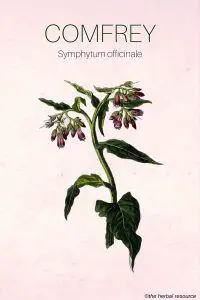Comfrey has traditionally been used a folk medicine for a variety of ailments, such as the topical treatment of painful muscles and joints, to aid the healing of wounds and skin cells, haematoma, broken bones, fractures, gangrene, inflammation, burns and sprains, bruises, gout.
It has also been taken internally for rheumatoid arthritis, colitis, stomach and digestive problems such as diarrhea, gallstones, and also pneumonia and pleurisy, and ulcers.
During World War I, it was used to help heal maggot-infested wounds. More recently, in the twentieth century, some medical professionals have tried to treat cancer patients with comfrey but as yet no scientific evidence has been found to confirm its usefulness in that regard.
These days, it remains a very popular herb because of its ability to heal tissue and other wounds so quickly. It is not recommended for deep wounds because it may heal the outer tissue quicker.
It can be beneficial as an herbal remedy for burns, bruises, and other superficial wounds.
Its success has been in its use as a topical treatment. When used in low concentrations comfrey has been used in beauty creams and treatments. The fluid secretions of the plant called the mucilage have been used for healthy skin, soothing and softening it, and due to the allantoin, skin cells are regenerated also.
Allantoin has also been found in other supplements as it is considered quite safe because it has been found in the human placenta and breast milk.
When in ointment form, a common therapeutic use for comfrey is the treatment of pain and inflammation, due to the ingredient of rosmarinic acid.
In regards to acute upper and lower back pain, a study by Giannetti in 2010, the root extract of comfrey was found to have a potent and clinically significant effect in reducing pain in the back.
Previously a study by Koll in 2004, found during several clinical trials that comfrey was effective in the treatment of strains and sprains and various other joint and muscle complaints.
It has also been noted that comfrey ointment is beneficial in the treatment of osteoarthritis of the knee because it decreases pain, and movement and quality of life are improved.
Other useful components of comfrey such as saponins have antibacterial and anti-edemagenic properties.
It also contains choline which causes vasodilation. Rosmaricnic acid, in addition to its anti-inflammatory uses also has astringent, antioxidant, antimutagen, antibacterial and antiviral benefits, and can help with allergies.
There is a mouthwash available that is made from comfrey that is used as an herbal treatment for sore throats, gum disease and vocal hoarseness. some herbalists say that it can be used as a medicinal herb for hemorrhoids or vaginal infections and is used as an herbal suppository.
Caution is advised for these remedies because comfrey is not completely safe for internal use. Individuals should seek the advice of a healthcare provider or trained herbal specialist before using it.
Although traditionally used internally for stomach ulcers, it has been found that comfrey does not cure ulcers.
Herbal Resource
Latest posts by Herbal Resource (see all)
- What is Maritime Pine Bark used for? - December 23, 2023

Leave a Reply